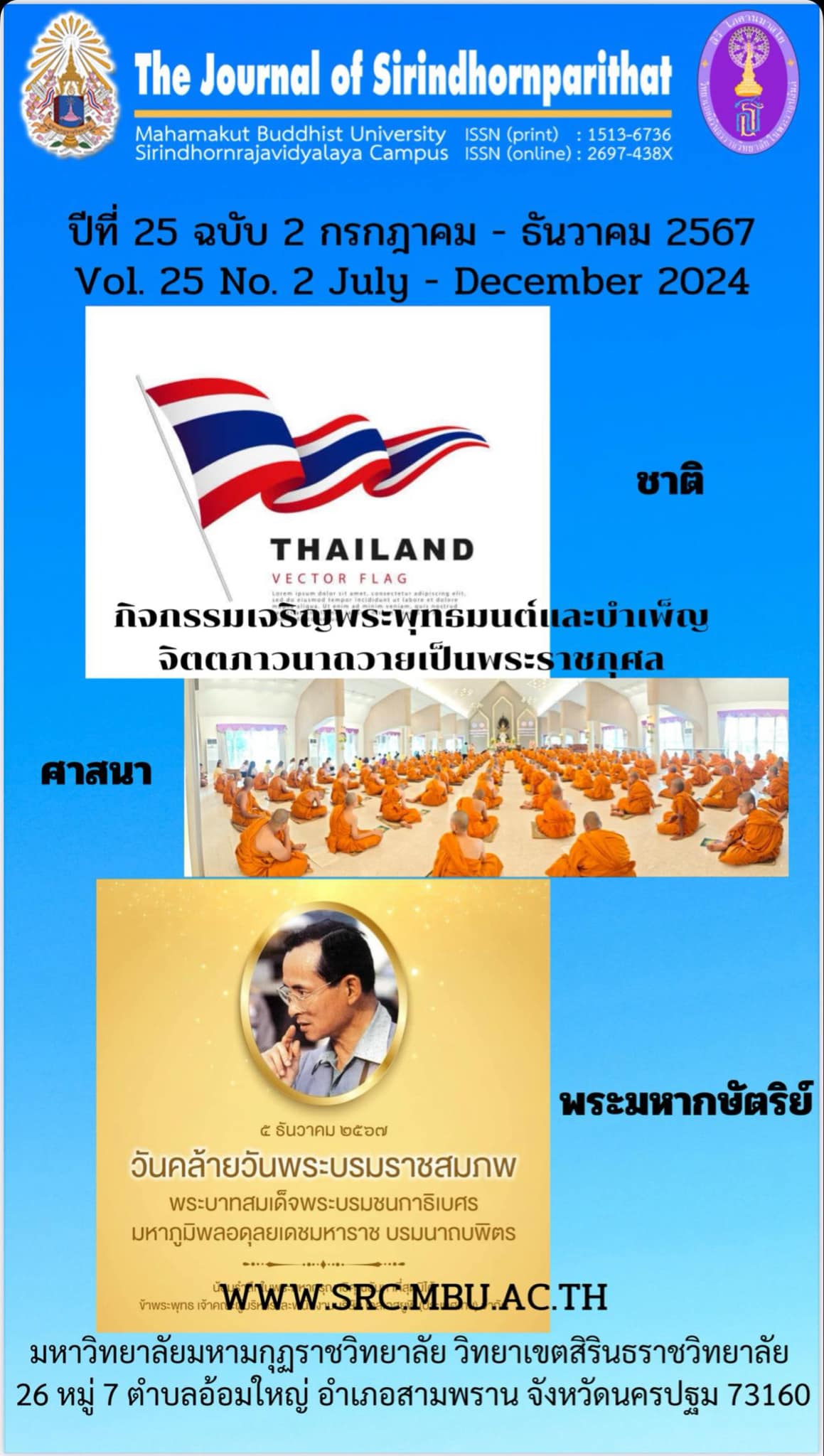Quality educational quality in educational institutions using multiple intelligences theory : A New Dimension of Educational Management for Sustainable Development
Keywords:
Educational Quality, Multiple Intelligences Theory, Sustainable DevelopmentAbstract
Educational quality in educational institutions by using teaching and learning management that responds to learners according to their aptitudes and interests, which will respond to learners, leading to sustainable educational development. It's a challenge. especially teaching and learning using the theory of multiple intelligences As Howard Gardner (Howard Gardner, 1983) suggests the idea that There are many aspects of human intelligence that are equally important. It depends on who stands out in which area. For example, if a child has no numeracy at all, He can also excel in other subjects such as art, etc. In this regard, Gardner did not say that the boy would be good at only one subject. But probably talented in many areas, at least he has one or two distinct qualities. It focuses on developing the ability to apply knowledge, skills, attitudes and characteristics in a holistic way in work. Problem-solving and living is a teaching that is linked to real life. Learning to be able to use it in different situations is learning to take advantage. It is not just learning to know, in the same way to say that a child is smart. Or how much ability If we take the level of intelligence or IQ that are currently used as a measure It may only have a fraction of the effect. Because it can only measure language, logic, mathematics, and spatial dimensions only. There are many areas of competence that current tests cannot cover such as musical ability. athletic ability and artistic abilities, etc.This article aims to present an approach to use the theory of multiple intelligences. in educational management of educational institutions for sustainable educational development with an integrated learning management model To enhance the abilities and aptitudes that are appropriate and consistent with the learners. The students who learned according to the developed learning management model had desirable characteristics. according to the specified criteria The Learners have higher academic achievement in the subjects they specialize in. and to improve the educational quality of educational institutions by using the theory of multiple intelligences for sustainable development for "students" in educational institutions with quality and to be able to develop the intelligence of each person to their full potential Therefore, it is a new dimension of education management in educational institutions in the present day. by using the theory of multiple intelligences To be a tool to develop the intelligence of learners with a goal and consistent with the problem community context and needs In order to enable people in the community to develop themselves, society and the local community sustainably. consequences That is, the school will be the property of the community that must have a duty to develop education in all systems and dimensions, with the school as the operator to organize learning activities that emphasize the use of multiple intelligences as the main point in educational management. to develop people for sustainable development in the future.
References
ทิศนา แขมมณี. (2550). ศาสตร์การสอน องค์ความรู้เพื่อพัฒนาการกระบวนการเรียนรู้ที่มีประสิทธิภาพ. กรุงเทพฯ : สำนักพิมพ์จุฬาลงกรณ์มหาวิทยาลัย.
นิกูล ชุ่มมั่น. (2563). อุตสาหกรรมศึกษาและการเสริมสร้างสมรรถนะผู้เรียน. วารสารวิชาการอุตสาหกรรมศึกษา คณะศึกษาศาสตร์มหาวิทยาลัยศรีนครินทรวิโรฒ. 14(2), 60-74.
ยุทธนา กาเด็ม. (2564). แนวทางการปรับปรุงการเรียนการสอนที่สอดคล้องกับความต้องการของผู้เรียนแบบมีส่วนร่วม. ยะลา : มหาวิทยาลัยราชภัฏยะลา.
วิชัย วงษ์ใหญ่ และคณะ. (2564). พหุปัญญาในชั้นเรียน Multiple Intelligence in Classroom. กรุงเทพฯ: มหาวิทยาลัยศรีนครินทรวิโรฒ.
สุวิทย์ ยอดสละ. (2556). การพัฒนาภาวะผู้นำเชิงวิสัยทัศน์ของผู้บริหารโรงเรียนประถมศึกษา สังกัดสำนักงาน คณะกรรมการการศึกษาขั้นพื้นฐาน. (วิทยานิพนธ์ปริญญาการศึกษาดุษฎีบัณฑิต) สาขาวิชาการบริหาร และพัฒนาการศึกษา บัณฑิตวิทยาลัย มหาวิทยาลัยมหาสารคาม.
สำนักงานเลขาธิการสภาการศึกษา. (2562). เเนวทางการพัฒนาสมรรถนะผู้เรียนระดับการศึกษาขั้นพื้นฐาน. กรุงเทพฯ : บริษัท 21 เซ็นจูรี่ จำกัด.
สำนักงานเลขาธิการสภาการศึกษา. (2562). รายงานผลการวิจัยและพัฒนากรอบสมรรถนะผู้เรียนระดับประถมศึกษาตอนต้นสำหรับหลักสูตรการศึกษาขั้นพื้นฐาน.
กรุงเทพฯ: บริษัท 21 เซ็นจูรี่ จำกัด.
สำนักงานคณะกรรมการการศึกษาแห่งชาติ, สำนักนายกรัฐมนตรี. (2545). พระราชบัญญัติการศึกษาแห่งชาติ พ.ศ. 2545. กรุงเทพฯ: บริษัทพริกหวานกราฟฟิตจำกัด.
อาภรณ์ ใจเที่ยง. (2550). หลักการสอน. (พิมพ์ครั้งที 4). กรุงเทพฯ: โอเดียนสโตร์.
อุมาพร เทียมทัด. (2556). ทฤษฎีพหุปัญญา. วารสารการวัดผลการศึกษา. 30(87), 9-14.
McClelland, D. C. (1973). Testing for competence rather than intelligence. American Psychologist, 28(1), 1-14.
Joyce, B. & Weil, M. (1996). Model of teaching. London: Allyn and Bacon.
Gardner, Howard. (1983). “Multiple Intelligence,” The In theory in Practice. 76(8), 92 - 102.
Gardner, Howard. (2006). Five Minds for the Future. Boston: Harvard Business School.
Downloads
Published
Issue
Section
License
Copyright (c) 2024 Mahamakut Buddhist University

This work is licensed under a Creative Commons Attribution-NonCommercial-NoDerivatives 4.0 International License.
บทความที่ได้รับการตีพิมพ์เป็นลิขสิทธิ์ของ มหาวิทยาลัยมหามกุฏราชวิทยาลัย วิทยาเขตสิรินธรราชวิทยาลัย
ข้อความที่ปรากฏในบทความแต่ละเรื่องในวารสารวิชาการเล่มนี้เป็นความคิดเห็นส่วนตัวของผู้เขียนแต่ละท่านไม่เกี่ยวข้องกับหาวิทยาลัยมหามกุฏราชวิทยาลัย วิทยาเขตสิรินธรราชวิทยาลัย และคณาจารย์ท่านอื่นๆในมหาวิทยาลัยฯ แต่อย่างใด ความรับผิดชอบองค์ประกอบทั้งหมดของบทความแต่ละเรื่องเป็นของผู้เขียนแต่ละท่าน หากมีความผิดพลาดใดๆ ผู้เขียนแต่ละท่านจะรับผิดชอบบทความของตนเองแต่ผู้เดียว




